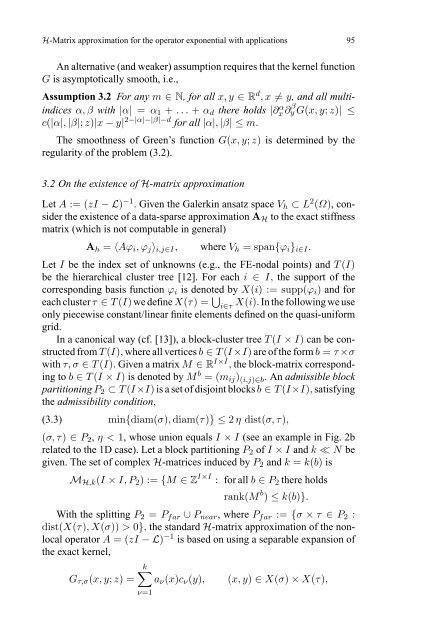H-Matrix approximation for the operator exponential with applications
H-Matrix approximation for the operator exponential with applications
H-Matrix approximation for the operator exponential with applications
Create successful ePaper yourself
Turn your PDF publications into a flip-book with our unique Google optimized e-Paper software.
H-<strong>Matrix</strong> <strong>approximation</strong> <strong>for</strong> <strong>the</strong> <strong>operator</strong> <strong>exponential</strong> <strong>with</strong> <strong>applications</strong> 95<br />
An alternative (and weaker) assumption requires that <strong>the</strong> kernel function<br />
G is asymptotically smooth, i.e.,<br />
Assumption 3.2 For any m ∈ N, <strong>for</strong> all x, y ∈ R d ,x ≠ y, and all multiindices<br />
α, β <strong>with</strong> |α| = α 1 + ... + α d <strong>the</strong>re holds |∂x α ∂y β G(x, y; z)| ≤<br />
c(|α|, |β|; z)|x − y| 2−|α|−|β|−d <strong>for</strong> all |α|, |β| ≤m.<br />
The smoothness of Green’s function G(x, y; z) is determined by <strong>the</strong><br />
regularity of <strong>the</strong> problem (3.2).<br />
3.2 On <strong>the</strong> existence of H-matrix <strong>approximation</strong><br />
Let A := (zI −L) −1 . Given <strong>the</strong> Galerkin ansatz space V h ⊂ L 2 (Ω), consider<br />
<strong>the</strong> existence of a data-sparse <strong>approximation</strong> A H to <strong>the</strong> exact stiffness<br />
matrix (which is not computable in general)<br />
A h = 〈Aϕ i ,ϕ j 〉 i,j∈I , where V h = span{ϕ i } i∈I .<br />
Let I be <strong>the</strong> index set of unknowns (e.g., <strong>the</strong> FE-nodal points) and T (I)<br />
be <strong>the</strong> hierarchical cluster tree [12]. For each i ∈ I, <strong>the</strong> support of <strong>the</strong><br />
corresponding basis function ϕ i is denoted by X(i) := supp(ϕ i ) and <strong>for</strong><br />
eachcluster τ ∈ T (I) we define X(τ) = ⋃ i∈τ<br />
X(i). In <strong>the</strong> following we use<br />
only piecewise constant/linear finite elements defined on <strong>the</strong> quasi-uni<strong>for</strong>m<br />
grid.<br />
In a canonical way (cf. [13]), a block-cluster tree T (I × I) can be constructed<br />
from T (I), where all vertices b ∈ T (I ×I) are of <strong>the</strong> <strong>for</strong>m b = τ ×σ<br />
<strong>with</strong> τ,σ ∈ T (I). Given a matrix M ∈ R I×I , <strong>the</strong> block-matrix corresponding<br />
to b ∈ T (I × I) is denoted by M b =(m ij ) (i,j)∈b . An admissible block<br />
partitioning P 2 ⊂ T (I×I) is a set of disjoint blocks b ∈ T (I×I), satisfying<br />
<strong>the</strong> admissibility condition,<br />
(3.3) min{diam(σ), diam(τ)} ≤2 η dist(σ, τ),<br />
(σ, τ) ∈ P 2 , η 0}, <strong>the</strong> standard H-matrix <strong>approximation</strong> of <strong>the</strong> nonlocal<br />
<strong>operator</strong> A =(zI −L) −1 is based on using a separable expansion of<br />
<strong>the</strong> exact kernel,<br />
k∑<br />
G τ,σ (x, y; z) = a ν (x)c ν (y), (x, y) ∈ X(σ) × X(τ),<br />
ν=1
















